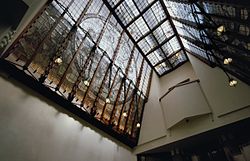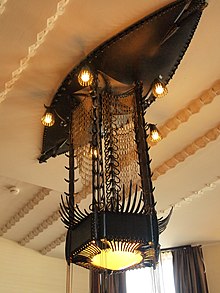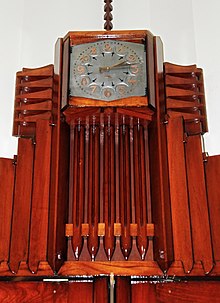
The Amsterdam School is a style of architecture that arose from 1910 through about 1930 in the Netherlands. The Amsterdam School movement is part of international Expressionist architecture, sometimes linked to German Brick Expressionism.

Joan (Jo) Melchior van der Mey was a Dutch architect best known for the landmark Scheepvaarthuis building in Amsterdam located at Prins Hendrikkade, 1912.

Amsterdam Centraal station is the largest railway station in Amsterdam, North Holland, the Netherlands. A major international railway hub, it is used by 192,000 passengers a day, making it the second busiest railway station in the country after Utrecht Centraal and the most visited Rijksmonument of the Netherlands.

Pieter Lodewijk (Piet) Kramer was a Dutch architect, one of the most important architects of the Amsterdam School.
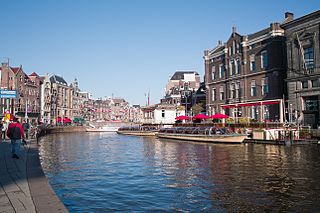
The Rokin is a canal and major street in the centre of Amsterdam. The street runs from Muntplein square to Dam square. The Rokin canal used to run from Muntplein square to Dam Square, but in 1936, the part between Spui square and Dam Square was filled in. Canal boats are now moored on the remaining part of the water, from the Amstel to Grimburgwal.

Maastricht Institute of Arts, formerly known as the Academie Beeldende Kunsten Maastricht and the Stadsacademie voor Toegepaste Kunsten, is a cluster of visual arts education from Zuyd University of Applied Sciences in Maastricht. The institute offers higher education in Bachelor of Education, Fine Arts and Design, Communication Design, Architecture and Interior Design, Interdisciplinary Arts, and in Master of Scientific Illustration, Architecture and Interior Design. Since 2020, the institute, in cooperation with the Academies of Music and Theatre, the Jan van Eyck Academy and Maastricht University, has offered the possibility of a doctorate in the visual arts. The institute focuses on the meaning of art as a phenomenon in its own right, with its own insights and laws.

Stoomvaart Maatschappij Nederland or SMN, also known as the Netherland Line or Nederland Line, was a Dutch shipping line that operated from 1870 until 1970, when it merged with several other companies to form what would become Royal Nedlloyd.

The Basilica of Saint Nicholas is located in the Old Centre district of Amsterdam, Netherlands, very close to Amsterdam's main railway station. St, Nicholas is the patron saint of both the church and the city of Amsterdam. The basilica is the city's primary Roman Catholic church.

The Salisbury is a Grade II* listed pub on Grand Parade in Harringay, North London.

The Hôtel van Eetvelde is a historic town house in Brussels, Belgium. It was designed by Victor Horta for Edmond van Eetvelde, administrator of Congo Free State, and built between 1895 and 1898, in Art Nouveau style. It is located at 4, avenue Palmerston/Palmerstonlaan in the Squares Quarter. Two extensions, also designed by Horta, were added between 1898 and 1901.

The Stadsschouwburgof Amsterdam is the name of a theatre building at the Leidseplein in Amsterdam, Netherlands. The building is in the neo-Renaissance style dating back to 1894, and is the former home of the National Ballet and Opera.

De Bazel is a listed/protected historic building on the west side of the Vijzelstraat in Amsterdam, and stretches from the Herengracht to the Keizersgracht. It stands as an example of Brick Expressionism.
The former Land Register in Amsterdam is a well-known building situated on the Prins Hendrikkade in the center of Amsterdam, opposite of the Amsterdam Central Railway Station.

Nieuwmarkt is an underground metro station in the city centre of Amsterdam, Netherlands. Served by metro lines 51, 53, and 54 of the Amsterdam Metro, the station was constructed by sinking caissons with a length of 40 metres (130 ft). This construction method resulted in the demolition of parts of the Nieuwmarkt neighbourhood and was met with protests.
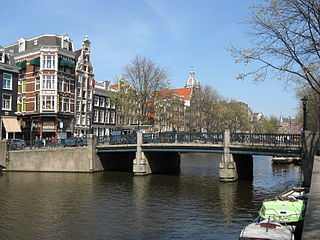
The Geldersekade is a canal and a street in Amsterdam that connects the Nieuwmarkt with the Prins Hendrikkade. The Geldersekade is in the easternmost part of De Wallen, the red light district, and borders Chinatown.

The Oudeschans, or Oude Schans, originally the Nieuwe Gracht, is a wide canal in the eastern part of the inner city of Amsterdam.
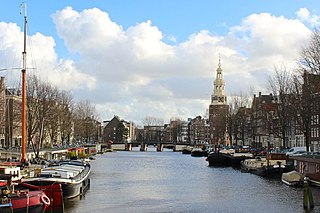
The Waalseilandsgracht, or Waalseilandgracht, is a short, wide canal in the east part of the inner city of Amsterdam.
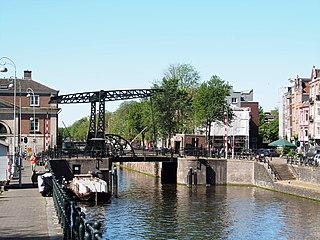
The Schippersgracht is a canal and street in the Centrum district of Amsterdam that runs from the Rapenburgerplein to the Prins Hendrikkade.

Prins Hendrikkade is a major street in the centre of Amsterdam. It passes Amsterdam Central Station, intersects the Damrak at the mouth of the Amstel river, and forms the southern end of the IJtunnel across the IJ bay. The street formed the northern edge and outer harbour of the city until the 19th century. It was named after Prince Henry of the Netherlands, youngest son of King William II, following Henry's death in 1879.

The Hôtel Hannon is a historic town house in Brussels, Belgium. Constructed between 1903 and 1904, in Art Nouveau style, for the industrialist Édouard Hannon, it is the only house in that style designed by the architect Jules Brunfaut.



